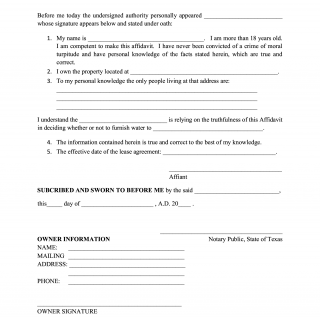Affidavit of Occupancy
An Affidavit of Occupancy is a legal document that certifies the occupancy of a property and is often required by lenders, landlords, or local government agencies. The main purpose of this form is to provide evidence that a person or people are living in a particular residence.
The form consists of several parts, including the name and address of the affiant, the property address, and a sworn statement that the affiant is currently occupying the property. Important fields to consider when writing the form include the date of occupancy, the names and ages of all occupants, and the affiant's signature.
The parties involved in this form are the affiant, who is the person making the statement, and the recipient of the form, who is often a lender, landlord, or local government agency. It is important to note that this form is notarized, meaning that it must be signed in the presence of a notary public who will verify the identity of the affiant and witness their signature.
When writing the form, data required includes the full name and address of the affiant, the property address, and the date of occupancy. Additionally, any supporting documents that can verify the affiant's occupancy, such as utility bills or lease agreements, should be attached to the form.
An example of when this form may be required is when a landlord needs to prove to a local government agency that their rental property is being occupied by tenants who meet certain income requirements. Another example is when a lender requires an affidavit of occupancy to verify that a borrower is living in a property that they have financed.
Strengths of this form include its ability to provide legal proof of occupancy, which can be useful in a variety of situations. Weaknesses include the potential for false statements or inaccuracies, which can lead to legal consequences. Opportunities for this form include its potential to help landlords and lenders comply with local regulations, while threats include the potential for fraud or misuse of the form.
Affidavit of Occupancy Sample
[Name of Affiant]
[Address of Affiant]
[City, State ZIP Code]
[Date][Name of Recipient]
[Address of Recipient]
[City, State ZIP Code]RE: Affidavit of Occupancy
To Whom It May Concern,
I, [Name of Affiant], hereby certify that I am currently occupying the property located at [Property Address], as of [Date of Occupancy]. I am the primary occupant of the property and reside at this address with [Number of Occupants] other occupants, whose names and ages are listed below:
1. [Name of Occupant], [Age of Occupant]
2. [Name of Occupant], [Age of Occupant]
3. [Name of Occupant], [Age of Occupant]I hereby declare, under penalty of perjury, that the foregoing is true and correct to the best of my knowledge and belief. I understand that this statement may be used by [Name of Recipient] for the purpose of verifying my occupancy of the property.
Sincerely,
[Signature of Affiant]
Sworn to and subscribed before me this [Date] day of [Month], [Year].
[Signature of Notary Public]
[Name of Notary Public]
My Commission Expires: [Date]
Related and alternative forms include a Certificate of Occupancy, which is a document issued by a local government agency that certifies that a building meets all applicable building codes and is safe to occupy. The main difference between the two forms is that the Certificate of Occupancy focuses on the safety of the building, while the Affidavit of Occupancy focuses on the occupancy of the property.
The Affidavit of Occupancy is typically submitted to the recipient in person or by mail. It is important to keep a copy of the form for personal records and to ensure that the recipient has received the original. The form is often stored in the recipient's records for future reference.

